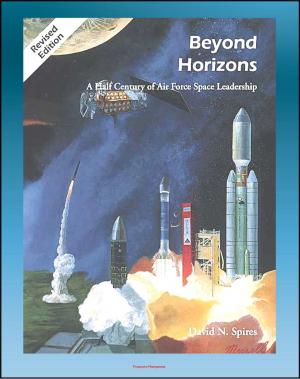The Noble Train of Artillery: A Study Comparison of Current Doctrinal Concepts of the Mission Command Philosophy in History - Case Study of Logistical Movement in the American Revolutionary War
Nonfiction, History, Americas, United States, Revolutionary Period (1775-1800), Military| Author: | Progressive Management | ISBN: | 9781370344215 |
| Publisher: | Progressive Management | Publication: | January 26, 2017 |
| Imprint: | Smashwords Edition | Language: | English |
| Author: | Progressive Management |
| ISBN: | 9781370344215 |
| Publisher: | Progressive Management |
| Publication: | January 26, 2017 |
| Imprint: | Smashwords Edition |
| Language: | English |
This excellent report has been professionally converted for accurate flowing-text e-book format reproduction. In the winter of 1775 and 1776 a logistical movement occurred which altered the tide of war in favor of the young American Continental Army. A bookseller from Boston volunteered to transport almost 60 pieces of artillery from the recently captured Fort Ticonderoga in upstate New York to Boston. This journey would take place in the dead of a New England winter, crossing over 300 miles of varying terrain. General George Washington subsequently utilized these cannons to force the occupying British forces to prematurely evacuate the city of Boston. The Boston bookseller was Henry Knox, who would later become one of Washington's key generals. He displayed several attributes during his expedition which compared directly with modern day US Army Doctrine concerning Mission Command philosophy.
CHAPTER 1 - INTRODUCTION * Definitions * Study Organization and Methodology * Limitations and Delimitations * Literature Review * CHAPTER 2 - THE SUMMER OF 1775 * CHAPTER 3 - THE NOBLE TRAIN OF ARTILLERY * The Operational Environment * 17th of November to the 1st of December 1775 * 1st to the 8th of December 1775 * 8th and 9th of December 1775. * 9th to the 17th of December 1775, 33 Miles, 10 Days * 17th to the 24th of December 1775, 10 Miles, 7 Days * 25th to the 27th of December 1775, 22 Miles, 2 Days * 28th of December 1775 to the 1st of January 1776, 28 Miles, 4 Days * 2nd to the 5th of January 1776, 16 Miles, 3 Days * 6th to the 10th of January 1776, 22 Miles, 4 Days * 11th and 12th of January 1776, 23 Miles, 2 Days * 12th to the 17th of January 1776, 59 Miles, 5 Days * 17th to the 20th of January 1776, 91 Miles, 3 Days * CHAPTER 4 - MISSION COMMAND CORRELATIONS IN HISTORY * Building Cohesive Teams through Mutual Trust * Create a Shared Understanding * Provide a Clear Commander's Intent. Exercise Disciplined Initiative * Use Mission Orders * Accept Prudent Risk * Doctrinal Correlation * Conclusion * CHAPTER 5 - CONCLUSION * Assessment of the Utilization of Mission Command * Interpretation of Findings * Conclusion * APPENDIX A * THE UTILIZATION OF MISSION COMMAND DISPLAYED BY KNOX DURING THE NOBLE TRAIN OF ARTILLERY EXPEDITION
The true purpose of this study is to demonstrate how Knox utilized the principles and philosophy of Mission Command during his expedition in 1775 and 1776. This study will use direct historical examples taken from Henry Knox's "Noble Train of Artillery" expedition that retrieved and transported 58 cannons from Fort Ticonderoga over 300 miles to Boston. The logistics of transporting these pieces in the dead of winter over small snow covered mountain trails, two major rivers, two lakes, and a minor mountain range in the Appalachian Mountains was no small accomplishment. A cohesive team was built based off of mutual trust which helped Knox accomplish this feat. The expedition would consist of over 40 militiamen, and 90 civilian teamsters responsible for 80 yoked oxen. The difficulty of this operation mandated decentralized execution. Knox could not be everywhere, so his orders needed to be clear and concise and the execution of the operation decentralized if his unorthodox unit were to achieve success. At its longest length Knox's expedition would stretch over five miles long and be organized into five separate movement serials. Knox's leadership helped guide this achievement through bringing this movement at one point from the brink of disaster.
This excellent report has been professionally converted for accurate flowing-text e-book format reproduction. In the winter of 1775 and 1776 a logistical movement occurred which altered the tide of war in favor of the young American Continental Army. A bookseller from Boston volunteered to transport almost 60 pieces of artillery from the recently captured Fort Ticonderoga in upstate New York to Boston. This journey would take place in the dead of a New England winter, crossing over 300 miles of varying terrain. General George Washington subsequently utilized these cannons to force the occupying British forces to prematurely evacuate the city of Boston. The Boston bookseller was Henry Knox, who would later become one of Washington's key generals. He displayed several attributes during his expedition which compared directly with modern day US Army Doctrine concerning Mission Command philosophy.
CHAPTER 1 - INTRODUCTION * Definitions * Study Organization and Methodology * Limitations and Delimitations * Literature Review * CHAPTER 2 - THE SUMMER OF 1775 * CHAPTER 3 - THE NOBLE TRAIN OF ARTILLERY * The Operational Environment * 17th of November to the 1st of December 1775 * 1st to the 8th of December 1775 * 8th and 9th of December 1775. * 9th to the 17th of December 1775, 33 Miles, 10 Days * 17th to the 24th of December 1775, 10 Miles, 7 Days * 25th to the 27th of December 1775, 22 Miles, 2 Days * 28th of December 1775 to the 1st of January 1776, 28 Miles, 4 Days * 2nd to the 5th of January 1776, 16 Miles, 3 Days * 6th to the 10th of January 1776, 22 Miles, 4 Days * 11th and 12th of January 1776, 23 Miles, 2 Days * 12th to the 17th of January 1776, 59 Miles, 5 Days * 17th to the 20th of January 1776, 91 Miles, 3 Days * CHAPTER 4 - MISSION COMMAND CORRELATIONS IN HISTORY * Building Cohesive Teams through Mutual Trust * Create a Shared Understanding * Provide a Clear Commander's Intent. Exercise Disciplined Initiative * Use Mission Orders * Accept Prudent Risk * Doctrinal Correlation * Conclusion * CHAPTER 5 - CONCLUSION * Assessment of the Utilization of Mission Command * Interpretation of Findings * Conclusion * APPENDIX A * THE UTILIZATION OF MISSION COMMAND DISPLAYED BY KNOX DURING THE NOBLE TRAIN OF ARTILLERY EXPEDITION
The true purpose of this study is to demonstrate how Knox utilized the principles and philosophy of Mission Command during his expedition in 1775 and 1776. This study will use direct historical examples taken from Henry Knox's "Noble Train of Artillery" expedition that retrieved and transported 58 cannons from Fort Ticonderoga over 300 miles to Boston. The logistics of transporting these pieces in the dead of winter over small snow covered mountain trails, two major rivers, two lakes, and a minor mountain range in the Appalachian Mountains was no small accomplishment. A cohesive team was built based off of mutual trust which helped Knox accomplish this feat. The expedition would consist of over 40 militiamen, and 90 civilian teamsters responsible for 80 yoked oxen. The difficulty of this operation mandated decentralized execution. Knox could not be everywhere, so his orders needed to be clear and concise and the execution of the operation decentralized if his unorthodox unit were to achieve success. At its longest length Knox's expedition would stretch over five miles long and be organized into five separate movement serials. Knox's leadership helped guide this achievement through bringing this movement at one point from the brink of disaster.















